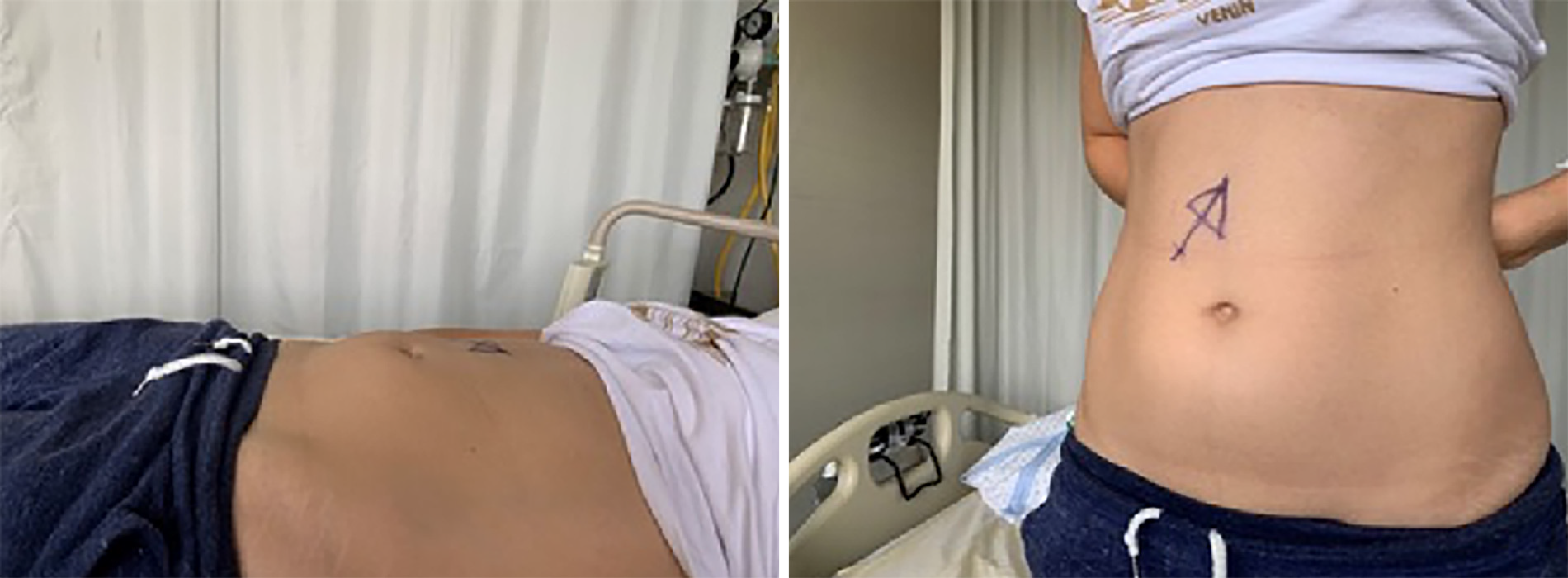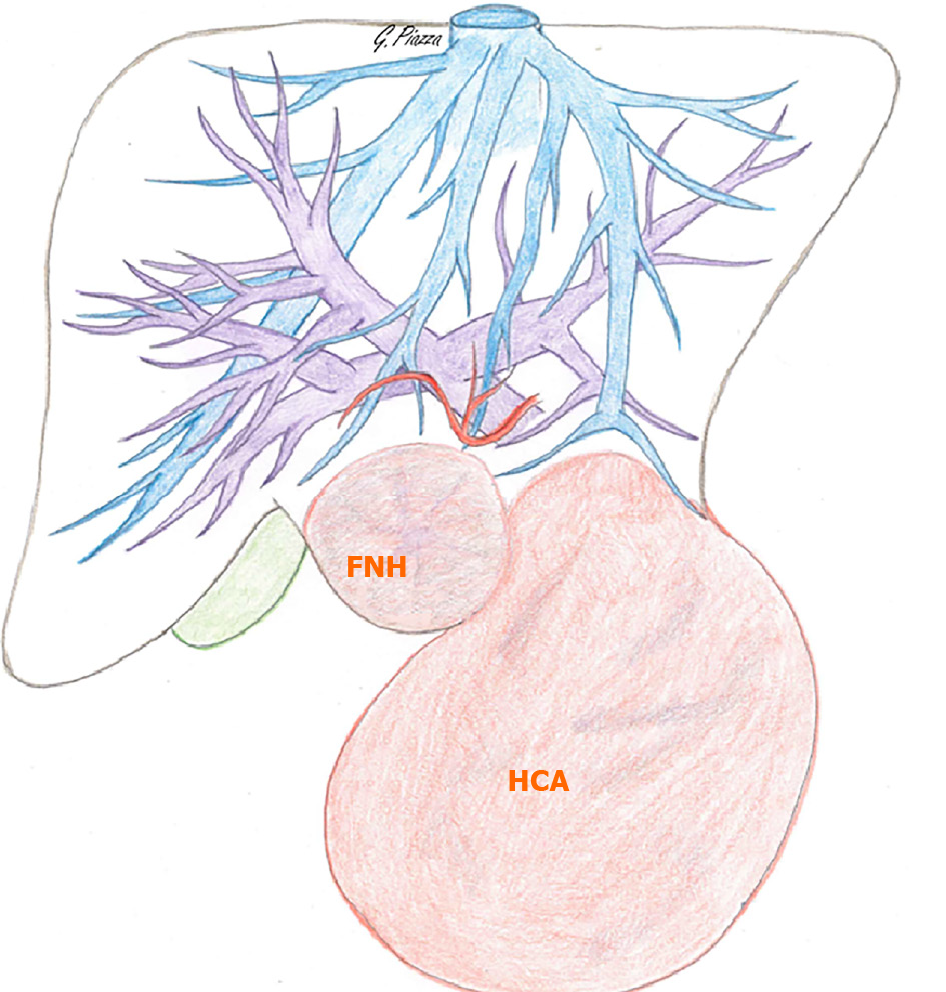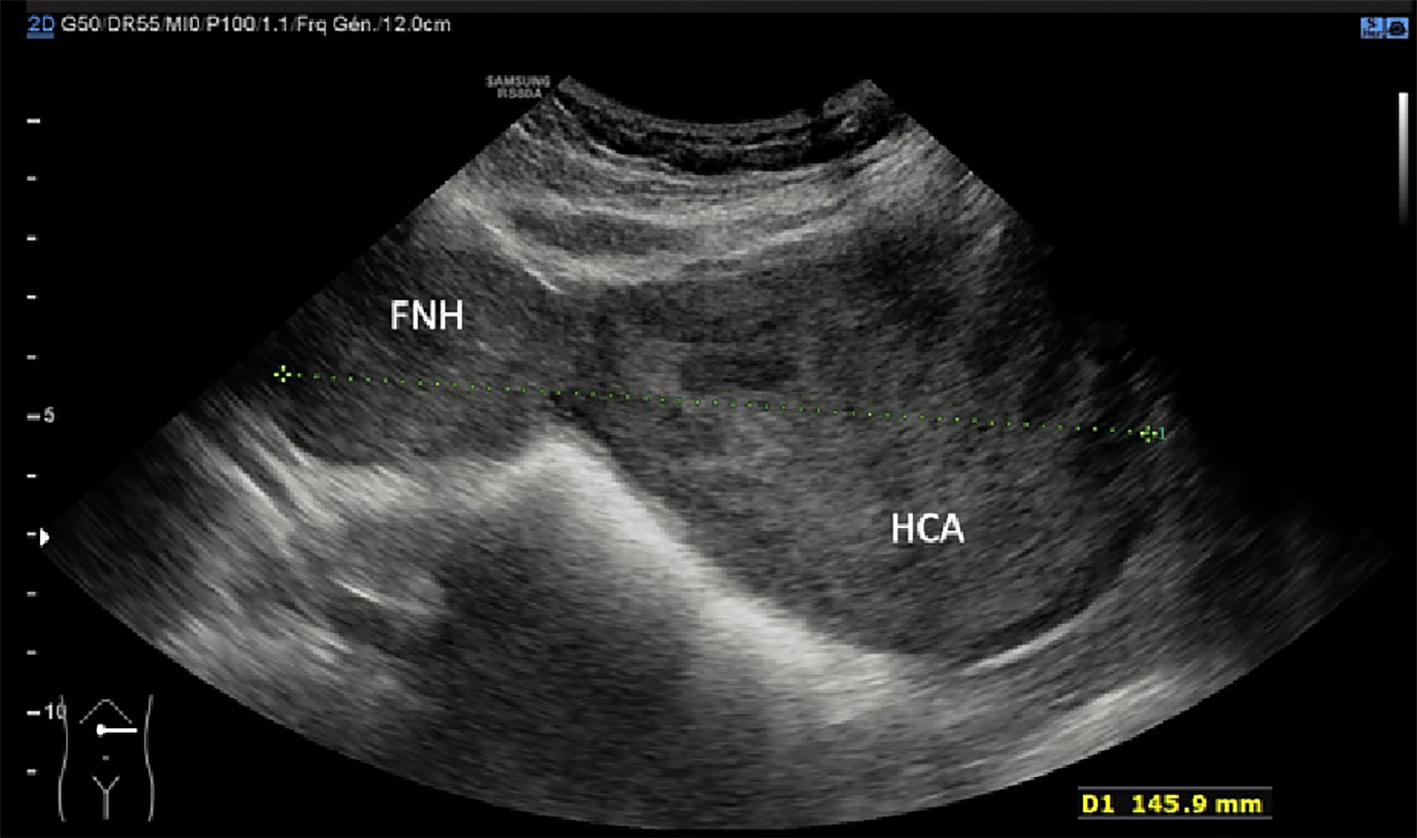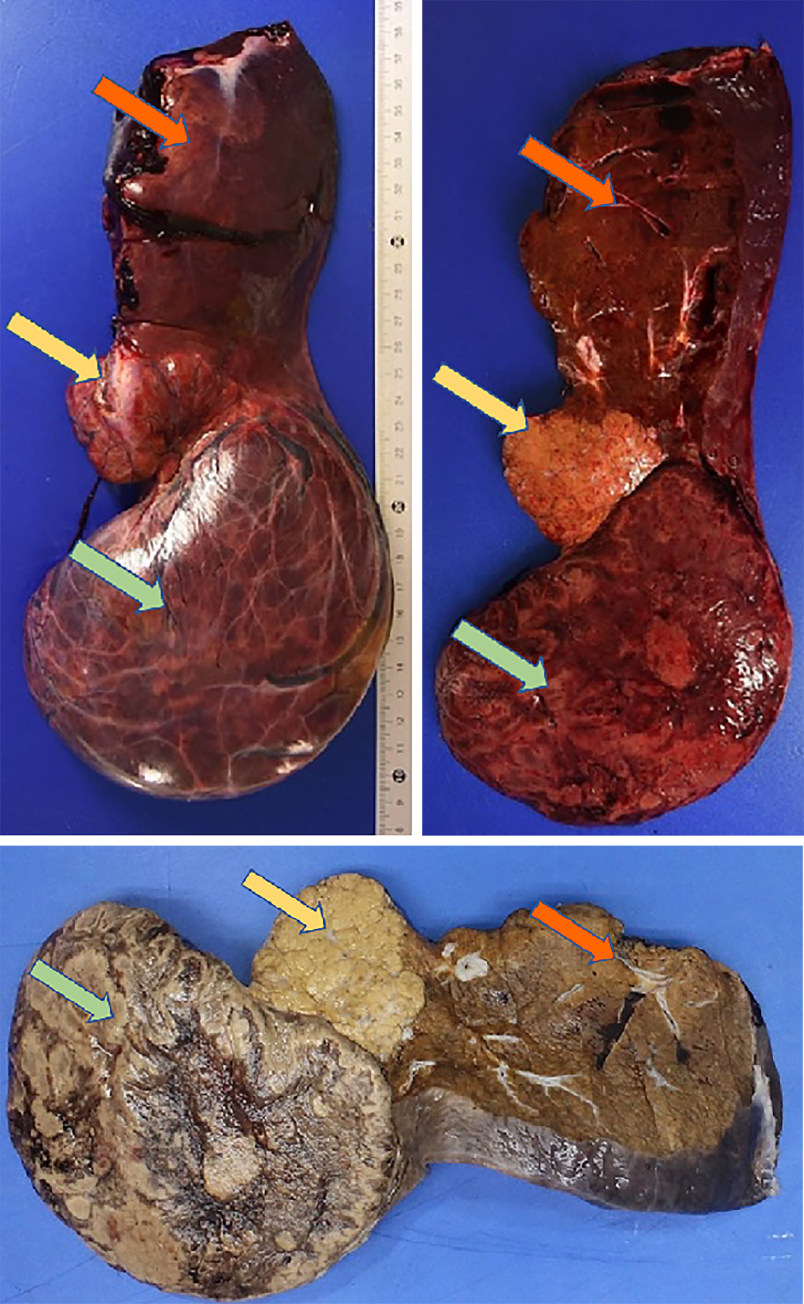Published online Oct 27, 2021. doi: 10.4254/wjh.v13.i10.1450
Peer-review started: April 25, 2021
First decision: June 4, 2021
Revised: June 15, 2021
Accepted: August 31, 2021
Article in press: August 31, 2021
Published online: October 27, 2021
Processing time: 179 Days and 15.5 Hours
Focal nodular hyperplasia (FNH) and hepatocellular adenoma (HCA) are well-known benign liver lesions. Surgical treatment is usually chosen for symptomatic patients, lesions more than 5 cm, and uncertainty of diagnosis.
We described the case of a large liver composite tumor in an asymptomatic 34-year-old female under oral contraceptive for 17-years. The imaging work-out described two components in this liver tumor; measuring 6 cm × 6 cm and 14 cm × 12 cm × 6 cm. The multidisciplinary team suggested surgery for this young woman with an unclear HCA diagnosis. She underwent a laparoscopic left liver lobectomy, with an uneventful postoperative course. Final pathological examination confirmed FNH associated with a large HCA. This manuscript aimed to make a literature review of the current management in this particular situation of large simultaneous benign liver tumors.
The simultaneous presence of benign composite liver tumors is rare. This case highlights the management in a multidisciplinary team setting.
Core Tip: Focal nodular hyperplasia and hepatocellular adenoma (HCA) are frequent but non-malignant tumors. There is rarely indication for surgery. Combination of these two masses is a very unusual situation. Their diagnosis is mainly based on radiology. Oral contraception is a risk factor for HCA. Malignant transformation of HCA is the predominant argument for surgery. All these cases, especially composite tumors, must be discussed in a multidisciplinary team.
- Citation: Gaspar-Figueiredo S, Kefleyesus A, Sempoux C, Uldry E, Halkic N. Focal nodular hyperplasia associated with a giant hepatocellular adenoma: A case report and review of literature. World J Hepatol 2021; 13(10): 1450-1458
- URL: https://www.wjgnet.com/1948-5182/full/v13/i10/1450.htm
- DOI: https://dx.doi.org/10.4254/wjh.v13.i10.1450
Focal nodular hyperplasia (FNH) has become a pretty well-known disease in the past two decades. It is defined by a benign hyperplasic nodule with a central scar, appearing in the normal liver parenchyma, and is composed of normal hepatocytes in a multinodular structure[1]. Its incidence is between 0.6%-3%, predominantly affecting females patients (80%-90%) in their third or fourth decade. The pathophysiology is thought to be due to an increased arterial flow that leads to secondary hepatocellular hyperplasia[2,3]. The correlation with oral contraceptives (OCs) is unproven but very likely, given that OCs are taken almost exclusively by women (sex ratio 9:1) and the proven correlation between OCs and change in lesion size[4,5].
Hepatocellular adenoma (HCA) is a benign lesion with a malignant potential between 4% and 8%, according to recent works of Farges et al[6] and Sempoux et al[7]. It classically arises in a noncirrhotic liver, in young females with an OC background. However, the understanding of HCA has evolved dramatically and we now know that it can also develop in patients with non-alcoholic steatohepatitis, certain vascular malformations, or alcoholic cirrhosis. Moreover, there are a wide variety of subtypes of this complex disease, making it very difficult to establish treatment guidelines[8-10].
In this present article, we aimed to describe the detailed management of a rare simultaneous case of FNH and HCA and a brief review of the literature.
A 34-year-old woman in general good health, with a medical history of oral contraceptives (desogestrel, ethinylestradiol) for 17 years consulted her general practitioner (GP) for a check-up.
She was completely asymptomatic.
She had no past illness.
The patient had no past medical history except a knee orthopedic surgery 1 year before, had a stable weight with normal body mass index (21.1 kg/m2) and no familial medical history.
During the examination, her GP found a mobile and palpable abdominal mass of more than 10 cm in diameter, with no skin bulging at the Valsalva's maneuver (Figure 1).
The blood exams were normal, except for an elevation in alkaline phosphate level of 519 U/L (normal range = 36-108). Tumoral markers were normal.
Abdominal ultrasound revealed an aspecific giant mass next to the left hepatic lobe. A computed tomography (CT scan) revealed a double mass attached to the left lobe of the liver. The first one had the typical characteristics of FNH and the second one of uncertain dignity. Further magnetic resonance imaging (MRI) confirmed a 6 cm x 6 cm mass suggestive of FNH in the inferior part of segment III. This 6 cm lesion was right next to a second one measuring 14 cm × 12 cm × 6 cm which dignity was unclear. The differential diagnosis was between an HCA, a hepatocellular carcinoma (fibrolamellar variant), or an atypical FNH (Figures 2-5).
The pathologist’s report confirmed the diagnosis of 6 cm FNH resected with good margin and showed a non-beta-catenin–mutated HCA (inflammatory subtype with more risk of malignant transformation) (Figure 6).
Indication for surgery was retained during a multidisciplinary team (MDT) meeting as the first option for definitive diagnosis and treatment.
The surgery was completed without complication. We summarize hereafter the key points of the minimally invasive procedure. After inserting 4 trocars for the laparoscopy (para-umbilical, right and left flank, subxiphoid) and staying away from the large dual mass which limited the range movements, we performed an ultrasound confirming a pedunculated mass (FNH) highly vascularized attached to segment III and a second component pedunculated between segment II and III. The mass showed no adhesion with the segment IV and the gallbladder allowing a left lobectomy. Dissection was performed with ultrasonic shears (Ultracision Harmonic, Ethicon Inc., NJ, United States) and transsection was completed with a 60mm stapler (tri-staple vascular cartridge, Endo-GIA, Medtronic, Minneapolis, MN, United States). We extracted the specimen with both lesions through a suprapubic (Pfannenstiel) incision. The operative time was 122 min. Blood loss was minimal (50 mL) (Video 1).
The postoperative course was uneventful and the patient was discharged on postoperative day 3.
The MDT meeting proposed a 1-year MRI follow-up with oral contraceptive discontinuation.
One month after surgery, the patient was good without any complaint, her scar evolution was satisfactory and there was no sign of an early incisional hernia.
The interest of this case lies in the simultaneous discovery of 2 adjacent but pathologically different benign liver lesions: the first one (FNH) without a strong indication for surgery and the second one requiring surgery because of its uncertain diagnosis.
FNH has no recognized risk of malignant transformation or bleeding and usually has an uneventful course. Therapeutic abstention is usually recommended for asymptomatic patients with a definitive diagnosis[11]. Surgical management is reserved for symptomatic patients or with diagnosis uncertainty despite a complete workup[12,13]. Twelve cases of spontaneous rupture of FNH are described and considering these extremely rare events, conservative treatment is the actual well-established standard of care [English-language literature until 2019; NCBI.gov with terms “spontaneous; rupture; FNH]. Close follow-up is however recommended for FNH more than 5 cm. Some authors advocate for upfront surgery with FNH larger than 5 cm[14-16]. However, we do not recommend a surgical resection in our daily practice but advocate for a close follow-up strategy. In the present case report, the diagnosis of FNH of the segment III lesion was radiologically typical and in the absence of the HCA component, a 1-year MRI follow-up would have been recommended.
On the contrary, the risk of malignant transformation of HCA is 4%-5%. As reported by Sempoux et al[7], risk factors for complications of HCA (bleeding or malignant transformation) are the size (> 5 cm), male gender, activating mutation in β-catenin, and specific clinical background (glycogen storage disease, androgens, vascular diseases). The resulting recommendations for surgery are based on initial size (> 5 cm), imaging or histological signs of malignancy, size progression after OC discontinuation, and male patients. Selected patients and those who are not fit for surgery can benefit from embolization[17-19]. When the diagnosis cannot be achieved with imaging, a percutaneous biopsy or resection may be required[20].
Moreover, Bröker et al[21] 2012 advocated the surgery for adenoma greater than 5 cm with patients who had planned a pregnancy. Our patient didn’t have a pregnancy plan but size and uncertainty of diagnosis were our principal arguments for surgery.
We made a literature review of the simultaneous cases of FNH and HA. Although there is some case reports in the eighties, the article was not available for consulting[22-25]. Table 1 summarizes the other cases with enough data.
| No. | Ref. | Sex, age | OC | Pathology - Size (cm) | Location (segment) | Symptoms | Treatment |
| #1 | Dimitroulis et al[26], 2012 | F, 18 yr | No | FNH – 2.5 | S3 | RUQ pain | Wedge resection |
| HA – 6 | S5-6 | Lt S5-6 | |||||
| #2 | Di Carlo et al[27], 2003 | F, 25 yr | No | FNH – < 5 | S4 | RUQ pain | En bloc (+ gallbladder) |
| HA – NA | S4 | Enucleation | |||||
| HH – > 4 | S2 | Enucleation | |||||
| HCy – NA | S5 | En bloc (+ gallbladder) | |||||
| #3 | Shih et al[28], 2015 | F, 40 yr | Yes | FNH – 6 | III | Abdominal pain | LH |
| HA – 9.5 & small ones (max 1.5 cm) | III for the largest, small ones on both lobes | ||||||
| #4 | Laurent et al[29], 2003 | F, 45 yr | Yes | FNH – 1 | S3 | Fatigue | Lt S3 segmentectomy + wedge |
| HA – NA | S7 | Lt RH | |||||
| F, 40 yr | Yes | FNH – 5 | S6 | None | Biopsy | ||
| FNH – 4 | S7 | Biopsy | |||||
| NA – 3 | Left lobe | Lt LH | |||||
| HA – 3 | Left lobe | Lt LH | |||||
| F, 38 yr | Yes | HA surrounded by FNH –13 | Right lobe | None | Lt RH | ||
| F, 29 yr | Yes | HA – 5 × 1 | S1 (bleeding), S2, 3, 7, 8 | Abdominal pain + shock | Lt LH + S1 | ||
| FNH – 1 | S6 | ||||||
| F, 41 yr | Yes | HA – 1 | RL | Abdominal pain | Lt RH | ||
| FNH – 1 | RL | ||||||
| #5 | Our case-report | F, 38 yr | Yes | 6 × 614 × 12 × 6 | S3 | None | Ls LL |
Case 1 was operated on because of the lack of obvious radiological evidence[26]. The authors of case 2 don’t clearly explain the indication for the operative procedure but they interestingly explain the possible same pathophysiological etiology for 4 different simultaneous hepatic masses[27].
Shih et al[28] made a left hepatectomy for a case with common features between FNH and HA and operate for the uncertainty of diagnosis.
The French group of Laurent et al[29] found in their records 5 over 30 patients operated for “benign hepatocytic nodules" with simultaneous HNF and adenoma. All of them went under surgery when the radiology reports an HA or unidentified mass. The diagnosis of FNH was already known at the time of the surgical procedure except for one case where the FNH was too small[29].
Concerning the surgical technique, the laparoscopic approach is relatively recent. Unfortunately, Shih et al[28] didn’t report this in their paper although they did the same procedure for a similar patient. Despite the lack of high-level evidence data (randomized control trials, meta-analysis), current literature about laparoscopic vs open liver surgery for benign tumors suggests an advantage for the minimal-invasive technique[30,31]. On the other hand, evidence for laparoscopic malign liver resection is much more consistent. Furthermore, safety, feasibility, and long-term results confirmed the advantages of laparoscopy for malign liver tumors[32-34].
We hereby report a laparoscopic resection of a macro-adenoma associated with focal nodular hyperplasia. The review of the literature shows that the simultaneous presence of these two masses is rare and that every case must be discussed in a multidisciplinary board. Factors like age, pregnancy wish, size, and uncertainty of diagnosis must be considered for shared decision in the setting of a multidisciplinary team. The laparoscopic approach should be preferred as much as possible.
We thank Dr. Giulia Piazza for her graphic representation of the case (Figure 2) which she has kindly drawn and for her courtesy in publishing it.
Manuscript source: Unsolicited manuscript
Specialty type: Gastroenterology and hepatology
Country/Territory of origin: Switzerland
Peer-review report’s scientific quality classification
Grade A (Excellent): A
Grade B (Very good): 0
Grade C (Good): 0
Grade D (Fair): 0
Grade E (Poor): 0
P-Reviewer: Beraldo RF S-Editor: Gong ZM L-Editor: A P-Editor: Guo X
| 1. | Rebouissou S, Bioulac-Sage P, Zucman-Rossi J. Molecular pathogenesis of focal nodular hyperplasia and hepatocellular adenoma. J Hepatol. 2008;48:163-170. [RCA] [PubMed] [DOI] [Full Text] [Cited by in Crossref: 182] [Cited by in RCA: 149] [Article Influence: 8.3] [Reference Citation Analysis (0)] |
| 2. | Fukukura Y, Nakashima O, Kusaba A, Kage M, Kojiro M. Angioarchitecture and blood circulation in focal nodular hyperplasia of the liver. J Hepatol. 1998;29:470-475. [RCA] [PubMed] [DOI] [Full Text] [Cited by in Crossref: 84] [Cited by in RCA: 63] [Article Influence: 2.3] [Reference Citation Analysis (0)] |
| 3. | Gaiani S, Piscaglia F, Serra C, Bolondi L. Hemodynamics in focal nodular hyperplasia. J Hepatol. 1999;31:576. [RCA] [PubMed] [DOI] [Full Text] [Cited by in Crossref: 17] [Cited by in RCA: 14] [Article Influence: 0.5] [Reference Citation Analysis (0)] |
| 4. | Giannitrapani L, Soresi M, La Spada E, Cervello M, D'Alessandro N, Montalto G. Sex hormones and risk of liver tumor. Ann N Y Acad Sci. 2006;1089:228-236. [RCA] [PubMed] [DOI] [Full Text] [Cited by in Crossref: 193] [Cited by in RCA: 193] [Article Influence: 10.2] [Reference Citation Analysis (0)] |
| 5. | Fukahori S, Kawano T, Obase Y, Umeyama Y, Sugasaki N, Kinoshita A, Fukushima C, Yamakawa M, Omagari K, Mukae H. Fluctuation of Hepatic Focal Nodular Hyperplasia Size with Oral Contraceptives Use. Am J Case Rep. 2019;20:1124-1127. [RCA] [PubMed] [DOI] [Full Text] [Full Text (PDF)] [Cited by in Crossref: 1] [Cited by in RCA: 1] [Article Influence: 0.1] [Reference Citation Analysis (0)] |
| 6. | Farges O, Ferreira N, Dokmak S, Belghiti J, Bedossa P, Paradis V. Changing trends in malignant transformation of hepatocellular adenoma. Gut. 2011;60:85-89. [RCA] [PubMed] [DOI] [Full Text] [Cited by in Crossref: 231] [Cited by in RCA: 204] [Article Influence: 13.6] [Reference Citation Analysis (0)] |
| 7. | Sempoux C, Balabaud C, Bioulac-Sage P. Pictures of focal nodular hyperplasia and hepatocellular adenomas. World J Hepatol. 2014;6:580-595. [RCA] [PubMed] [DOI] [Full Text] [Full Text (PDF)] [Cited by in Crossref: 17] [Cited by in RCA: 12] [Article Influence: 1.0] [Reference Citation Analysis (0)] |
| 8. | Calderaro J, Nault JC, Balabaud C, Couchy G, Saint-Paul MC, Azoulay D, Mehdaoui D, Luciani A, Zafrani ES, Bioulac-Sage P, Zucman-Rossi J. Inflammatory hepatocellular adenomas developed in the setting of chronic liver disease and cirrhosis. Mod Pathol. 2016;29:43-50. [RCA] [PubMed] [DOI] [Full Text] [Cited by in Crossref: 37] [Cited by in RCA: 38] [Article Influence: 3.8] [Reference Citation Analysis (0)] |
| 9. | Bioulac-Sage P, Sempoux C, Balabaud C. Hepatocellular adenoma: Classification, variants and clinical relevance. Semin Diagn Pathol. 2017;34:112-125. [RCA] [PubMed] [DOI] [Full Text] [Cited by in Crossref: 54] [Cited by in RCA: 61] [Article Influence: 6.1] [Reference Citation Analysis (0)] |
| 10. | Blanc JF, Frulio N, Chiche L, Sempoux C, Annet L, Hubert C, Gouw AS, de Jong KP, Bioulac-Sage P, Balabaud C. Hepatocellular adenoma management: call for shared guidelines and multidisciplinary approach. Clin Res Hepatol Gastroenterol. 2015;39:180-187. [RCA] [PubMed] [DOI] [Full Text] [Cited by in Crossref: 18] [Cited by in RCA: 20] [Article Influence: 1.8] [Reference Citation Analysis (0)] |
| 11. | Ashby PF, Alfafara C, Amini A, Amini R. Spontaneous Rupture of a Hepatic Adenoma: Diagnostic Nuances and the Necessity of Followup. Cureus. 2017;9:e1975. [RCA] [PubMed] [DOI] [Full Text] [Full Text (PDF)] [Cited by in Crossref: 2] [Cited by in RCA: 2] [Article Influence: 0.2] [Reference Citation Analysis (0)] |
| 12. | Navarro AP, Gomez D, Lamb CM, Brooks A, Cameron IC. Focal nodular hyperplasia: a review of current indications for and outcomes of hepatic resection. HPB (Oxford). 2014;16:503-511. [RCA] [PubMed] [DOI] [Full Text] [Cited by in Crossref: 22] [Cited by in RCA: 25] [Article Influence: 2.1] [Reference Citation Analysis (0)] |
| 13. | Jung JM, Hwang S, Kim KH, Ahn CS, Moon DB, Ha TY, Song GW, Jung DH. Surgical indications for focal nodular hyperplasia of the liver: Single-center experience of 48 adult cases. Ann Hepatobiliary Pancreat Surg. 2019;23:8-12. [RCA] [PubMed] [DOI] [Full Text] [Full Text (PDF)] [Cited by in Crossref: 6] [Cited by in RCA: 8] [Article Influence: 1.1] [Reference Citation Analysis (0)] |
| 14. | Kinoshita M, Takemura S, Tanaka S, Hamano G, Ito T, Aota T, Koda M, Ohsawa M, Kubo S. Ruptured focal nodular hyperplasia observed during follow-up: a case report. Surg Case Rep. 2017;3:44. [RCA] [PubMed] [DOI] [Full Text] [Full Text (PDF)] [Cited by in Crossref: 6] [Cited by in RCA: 10] [Article Influence: 1.1] [Reference Citation Analysis (0)] |
| 15. | Velíšková M, Vlk R, Halaška MJ, Minajev G, Krejčí T, Rob L. [Rupture of focal nodular hyperplasia in the 37th week of pregnanacy - case report]. Ceska Gynekol. 81:218-221. [PubMed] |
| 16. | Li T, Qin LX, Ji Y, Sun HC, Ye QH, Wang L, Pan Q, Fan J, Tang ZY. Atypical hepatic focal nodular hyperplasia presenting as acute abdomen and misdiagnosed as hepatocellular carcinoma. Hepatol Res. 2007;37:1100-1105. [RCA] [PubMed] [DOI] [Full Text] [Cited by in Crossref: 16] [Cited by in RCA: 13] [Article Influence: 0.7] [Reference Citation Analysis (0)] |
| 17. | Dokmak S, Paradis V, Vilgrain V, Sauvanet A, Farges O, Valla D, Bedossa P, Belghiti J. A single-center surgical experience of 122 patients with single and multiple hepatocellular adenomas. Gastroenterology. 2009;137:1698-1705. [RCA] [PubMed] [DOI] [Full Text] [Cited by in Crossref: 296] [Cited by in RCA: 259] [Article Influence: 15.2] [Reference Citation Analysis (1)] |
| 18. | van Vledder MG, van Aalten SM, Terkivatan T, de Man RA, Leertouwer T, Ijzermans JN. Safety and efficacy of radiofrequency ablation for hepatocellular adenoma. J Vasc Interv Radiol. 2011;22:787-793. [RCA] [PubMed] [DOI] [Full Text] [Cited by in Crossref: 44] [Cited by in RCA: 41] [Article Influence: 2.7] [Reference Citation Analysis (0)] |
| 19. | Karkar AM, Tang LH, Kashikar ND, Gonen M, Solomon SB, Dematteo RP, D' Angelica MI, Correa-Gallego C, Jarnagin WR, Fong Y, Getrajdman GI, Allen P, Kingham TP. Management of hepatocellular adenoma: comparison of resection, embolization and observation. HPB (Oxford). 2013;15:235-243. [RCA] [PubMed] [DOI] [Full Text] [Cited by in Crossref: 43] [Cited by in RCA: 39] [Article Influence: 3.0] [Reference Citation Analysis (0)] |
| 20. | European Association for the Study of the Liver (EASL). EASL Clinical Practice Guidelines on the management of benign liver tumours. J Hepatol. 2016;65:386-398. [RCA] [PubMed] [DOI] [Full Text] [Cited by in Crossref: 286] [Cited by in RCA: 347] [Article Influence: 34.7] [Reference Citation Analysis (2)] |
| 21. | Bröker ME, Ijzermans JN, van Aalten SM, de Man RA, Terkivatan T. The management of pregnancy in women with hepatocellular adenoma: a plea for an individualized approach. Int J Hepatol. 2012;2012:725735. [RCA] [PubMed] [DOI] [Full Text] [Full Text (PDF)] [Cited by in Crossref: 26] [Cited by in RCA: 22] [Article Influence: 1.6] [Reference Citation Analysis (0)] |
| 22. | Reichlin B, Stalder GA, Rüedi T, Bianchi L. [Co-occurring liver cell adenoma and focal nodular hyperplasia due to contraceptives. Case report]. Schweiz Med Wochenschr. 1980;110:873-874. [PubMed] |
| 23. | Bartók I, Decastello A, Csikós F, Nagy I. Focal nodular hyperplasia of the liver and hepatic cell adenoma in women on oral contraceptives. Hepatogastroenterology. 1980;27:435-440. [PubMed] |
| 24. | Defrance R, Zafrani ES, Hannoun S, Saada M, Fagniez PL, Métreau JM. [Association of hepatocellular adenoma and focal nodular hyperplasia of the liver in a woman on oral contraceptives]. Gastroenterol Clin Biol. 1982;6:949-950. [PubMed] |
| 25. | Tajada M, Nerín J, Ruiz MM, Sánchez-Dehesa M, Fabre E. Liver adenoma and focal nodular hyperplasia associated with oral contraceptives. Eur J Contracept Reprod Health Care. 2001;6:227-230. [PubMed] |
| 26. | Dimitroulis D, Charalampoudis P, Lainas P, Papanikolaou IG, Kykalos S, Kouraklis G. Focal nodular hyperplasia and hepatocellular adenoma: current views. Acta Chir Belg. 2013;113:162-169. [RCA] [PubMed] [DOI] [Full Text] [Cited by in Crossref: 4] [Cited by in RCA: 3] [Article Influence: 0.2] [Reference Citation Analysis (0)] |
| 27. | Di Carlo I, Urrico GS, Ursino V, Russello D, Puleo S, Latteri F. Simultaneous occurrence of adenoma, focal nodular hyperplasia, and hemangioma of the liver: are they derived from a common origin? J Gastroenterol Hepatol. 2003;18:227-230. [RCA] [PubMed] [DOI] [Full Text] [Cited by in Crossref: 34] [Cited by in RCA: 26] [Article Influence: 1.1] [Reference Citation Analysis (0)] |
| 28. | Shih A, Lauwers GY, Balabaud C, Bioulac-Sage P, Misdraji J. Simultaneous occurrence of focal nodular hyperplasia and HNF1A-inactivated hepatocellular adenoma: a collision tumor simulating a composite FNH-HCA. Am J Surg Pathol. 2015;39:1296-1300. [RCA] [PubMed] [DOI] [Full Text] [Cited by in Crossref: 9] [Cited by in RCA: 7] [Article Influence: 0.6] [Reference Citation Analysis (0)] |
| 29. | Laurent C, Trillaud H, Lepreux S, Balabaud C, Bioulac-Sage P. Association of adenoma and focal nodular hyperplasia: experience of a single French academic center. Comp Hepatol. 2003;2:6. [RCA] [PubMed] [DOI] [Full Text] [Full Text (PDF)] [Cited by in Crossref: 49] [Cited by in RCA: 30] [Article Influence: 1.3] [Reference Citation Analysis (0)] |
| 30. | Wabitsch S, Kästner A, Haber PK, Benzing C, Krenzien F, Andreou A, Kamali C, Lenz K, Pratschke J, Schmelzle M. Laparoscopic Versus Open Liver Resection for Benign Tumors and Lesions: A Case Matched Study with Propensity Score Matching. J Laparoendosc Adv Surg Tech A. 2019;29:1518-1525. [RCA] [PubMed] [DOI] [Full Text] [Cited by in Crossref: 10] [Cited by in RCA: 12] [Article Influence: 1.7] [Reference Citation Analysis (0)] |
| 31. | Schmelzle M, Krenzien F, Schöning W, Pratschke J. Laparoscopic liver resection: indications, limitations, and economic aspects. Langenbecks Arch Surg. 2020;405:725-735. [RCA] [PubMed] [DOI] [Full Text] [Full Text (PDF)] [Cited by in Crossref: 22] [Cited by in RCA: 56] [Article Influence: 9.3] [Reference Citation Analysis (0)] |
| 32. | Jiang S, Wang Z, Ou M, Pang Q, Fan D, Cui P. Laparoscopic Versus Open Hepatectomy in Short- and Long-Term Outcomes of the Hepatocellular Carcinoma Patients with Cirrhosis: A Systematic Review and Meta-Analysis. J Laparoendosc Adv Surg Tech A. 2019;29:643-654. [RCA] [PubMed] [DOI] [Full Text] [Cited by in Crossref: 11] [Cited by in RCA: 17] [Article Influence: 2.4] [Reference Citation Analysis (0)] |
| 33. | Yin Z, Fan X, Ye H, Yin D, Wang J. Short- and long-term outcomes after laparoscopic and open hepatectomy for hepatocellular carcinoma: a global systematic review and meta-analysis. Ann Surg Oncol. 2013;20:1203-1215. [RCA] [PubMed] [DOI] [Full Text] [Cited by in Crossref: 149] [Cited by in RCA: 163] [Article Influence: 12.5] [Reference Citation Analysis (0)] |
| 34. | Cipriani F, Rawashdeh M, Stanton L, Armstrong T, Takhar A, Pearce NW, Primrose J, Abu Hilal M. Propensity score-based analysis of outcomes of laparoscopic versus open liver resection for colorectal metastases. Br J Surg. 2016;103:1504-1512. [RCA] [PubMed] [DOI] [Full Text] [Cited by in Crossref: 98] [Cited by in RCA: 98] [Article Influence: 9.8] [Reference Citation Analysis (0)] |


















